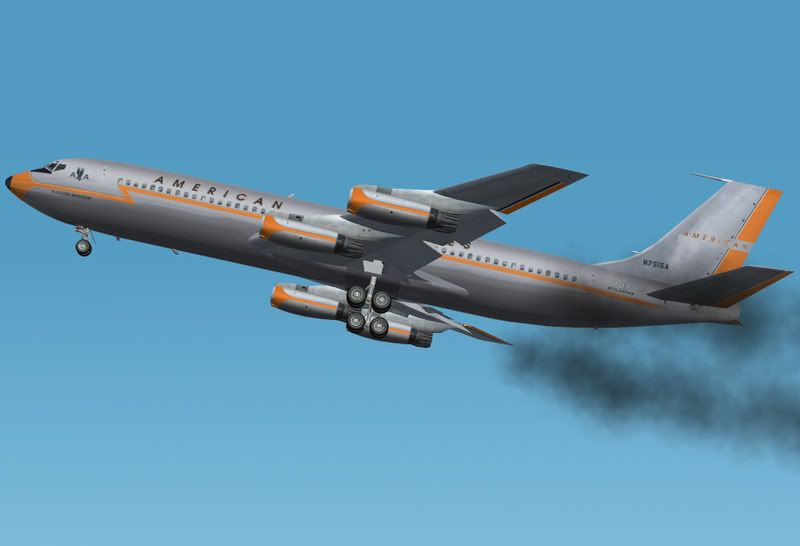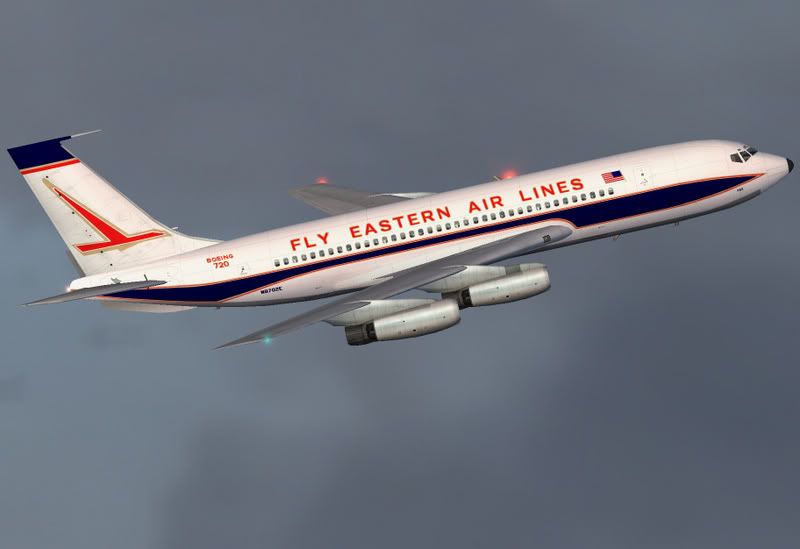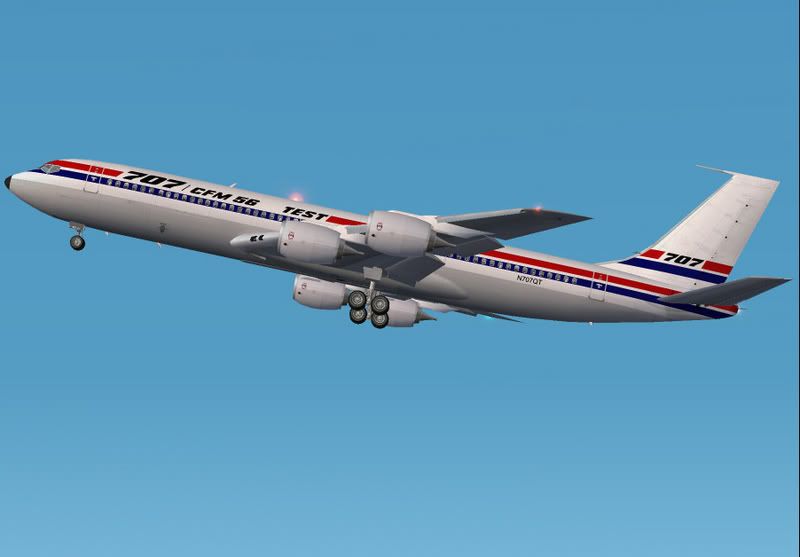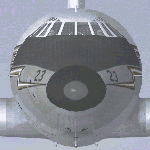B707 is without a doubt the best known of all first generation civil jetliners. Originating from a USAF requirement for jet powered aerial refuellers during the mid 1950's, this aircraft evolved through several turbojet and fanjet powered models of varying structural configurations and performance capabilities, to ultimately transform the Boeing company from obscurity to the forefront of world jetliner production and become one of the most successful civil aircraft projects ever.
"B367-80" .... otherwise known as "DASH 80" .... was the aircraft which spawned the B707 legend. Intended as a jet tanker/transport demomstrator, design work on this new aircraft commenced during 1952 under the preliminary 707-6 title which was publicly announced as B367-80 during September 1952. This designation was intended to mislead competition into believing the new aircraft was a jet powered derivative of Boeing's (B377 piston engine based) KC97 tanker then in service with the USAF rather than a prospective commercial transport. Fully funded by Boeing to the tune of some $16 milion (1952) dollars, it was hoped to reclaim much of this expenditure through Independant Research & Development funding followed by long term production of both military and civil contracts. It was also originally anticipated construction of both variants would utilize the same tooling too, but, through market pressures and the logical evolution of design improvement what emerged were 2 distinctly different families of aircraft with little in common with each other despite their similar external silhouette. B367-80 was completed some 2 weeks ahead of schedule and rolled-out at Boeing/Renton on March 14th l954 christianed "Jet Stratoliner". On July 15th 1954 the new aircraft performed its maiden flight .... and the B707 legend born.

B367-80 had a fuselage length of 127ft 10in. Wingspan of 130ft, and fuselage diameter of 132in. At the time of its first flight the aircraft was powered by 4 P&W JT3P turbojet engines (with water injection) rated at 9,500-11,000lb/st each (without thrust reversers). MTOW was 190,000lb, with a payload range of some 2,600nm.
Throughout a long service career B367-80 was extensively used by Boeing for both demonstration and development work in support of C135, B707, & B727 programes and later on scientific research projects. This saw the aircraft constantly modified over the years. By 1971 B367-80 had outlived its usefulness as a research/development platform and was withdrawn from service. It was donated to the National Air & space Museum/Smithsonian Institution on November 26th 1972 then stored at Davis-Monthan AFB Arizona for some 18 years. Resurrected from the desert on May 7th 1990, B367-80 was flown home to its Seattle birthplace for refurbishment and display in the Boeing Museum of Flight .... as one of the single most important aircraft of the jet age.
Early B367-80 demostration flights soon convinced the USAF of the aircrafts tanker/transporter potential. This resulted in significant military contracts for production of an aircraft Boeing designated "B717" and which became "C135" on the USAF inventory. The first production aircraft .... a "KC135-A" named "City of Renton" .... was rolled-out at Boeing/Renton on July 18th 1956 and first flew on August 31st 1956. It was delivered to USAF/SAC at Castle AFB California on June 28th 1957. Over time the production of C135 "series" aircraft for the USAF amassed to some 820 airframes over a wide range of derivatives to fulfill numerous specialist air roles in military/government service.

Early production C135-A's had a fuselage length of 136ft 2in. Wingspan of 130ft 10in, and fuselage diameter of 144in. These aircraft were powered by 4 P&W J57-P-59W turbojet engines (with water injection) rated at 11,200-13,000lb/st each, with MTOW (overload) of 300,000lbs .... though typically this was much reduced to 112,400-261,000lbs. Despite their logistical importance and versatility early KC135-A aircraft were among the most noisy, dirty, and airfield demanding aircraft on the USAF inventory, requiring no less than 10,000-13,700ft of runway to get airborne .... depending on load/overload situations.
The first civil version of Boeing's new jet design was preliminarily designated B707-7 which became "B707-120". This was intended as a domestic/transcontinental aircraft. The very first civil order for the type was placed by Pan American on October 17th 1955. B707-120 first flew on December 20th l957 and was awarded FAA certification on September 18th 1958. On October 26th l958 the new jetliner entered service on Pan American's New York/Paris route .... though beaten into transatlantic service by some 22 days when BOAC operated the first ever transatlantic jetliner service with COMET 4 along its London/New York/London route. American Airlines, Continental Airlines, and TWA also placed B707-120's into revenue service.

All B707-120's had a fuselage length of 144ft 6in and initially featured short tails. Wingspan of 130ft 10in, with a fuselage diameter of 148in .... this became the standard fuselage diameter for all subsequent production 707 models. These aircraft were powered by 4 P&W JT3C-6 turbojet engines (with water injection) rated at 11,200-13,500lb/st each, with MTOW of 247,000lb, and range of some 2,670nm depending on payload and reserves.
During the early 1960's most B707-120 aircraft were upgraded to "B707-120B" standard. All featuring increased tail height, ventral fin, powered rudder, and more powerful fuel efficient and environmentally acceptable P&W JT3D-1 or JT3D-3 fanjet engines rated at between 17,000-18,000lbs/st each (depending on airline powerplant selection), promoting increased MTOW of 257,000lb and improved range of some 3,680nm depending on payload and reserves.

B707-120B first flew on June 22nd 1960. Only American Airlines, Continental Airlines, and TWA ordered new-build -120B's which accounted for some 72 of the total 128 B707-120 series aircraft delivered. A small number of B707-120B's were later converted to pure freighters and redesignated "B707-120BF" .... as was the case with one such very rare example operated by Aeroconder Colombia during the late 1970's.

A number of original B707-120 aircraft (such as those operated by Pan American) were only progressively modified. These recieved the tail and ventral fin modifications immediately, but, retained their original turbojet engines prior later re-enginning with fanjet powerplants.
After long evaluating what jetliner would best succeed its CONSTELLATION fleet, Australia's QANTAS Airways finally selected a unique 707 version .... "B707-138". This was essentially a -120 airframe shortened by 10 ft to promote increased range for a slight payload disadvantage, but, ideally suited for the airlines long transpacific services. It was this willingness to tailor the 707 design to customer specification very early in the types production life which contributed significantly to Boeing's success over the competition.

The first 6 QANTAS B707-138's delivered from 1959-1960. All featured short tail and P&W JT3C-6 turbojet characteristics of original the B707-120's, but, the airlines last 6 -138's delivered between 1961-1964 were all built to "-120B" standard featuring the same structural and powerplant modifications .... becomming "B707-138B's" .... even further enhancing this already high performance aircraft and earning it the in-house accolade "hot rod". The original 6 QANTAS B707-138's were upgraded to -B standard during the early 1960's. These aircraft served QANTAS until 1968 when replaced with larger B707-320C's. Beyond their Australian service these unique 707's saw service with Braniff International, British Eagle Airways, Laker Airways, Pacific Western Airlines, and BWIA. 1 such aircraft remains operational today .... "N707JT - Jett Clipper Ella" .... the private transport of celebrety John TRAVOLTA.

B707-138B aircraft had a fuselage length of 134ft 6in. Wingpan of 130ft 10 in. These aircraft were powered by 4 P&W JT3D series fanjet engines rated at 17,000lb/st each, with MTOW of 257,000lbs, and range of some 4,900nm depending on payload and reserves.
Early series -20 and -30 DC8's were more powerful than intitial B707-120's prompting Boeing to respond with another unique 707 model marketed as "B707-220". Originally conceived as a shorter and narrower fuselage development, this aircraft ultimately evolved into a lower MTOW B707-120 with more powerful turbojet engines .... promoting improved airfield performance and ideally suited for "hot and high" operations. B707-220 first flew on May 11th 1959. Like B707-120 and -138 series aircraft, the -220 series also initially featured short tails. After a Braniff acceptance flight accident on October 19th 1959, and to comply with British Certification requirements (applied to all B707 aircraft from mid 1960), tall tail and ventral fin modifications were later retrofitted to improve lateral stability during assymetric conditions. Only 5 B707-220's were ever built. All were delivered to Braniff International Airways and operated along the airlines Latin American routes until 1971. Some of these aircraft later saw service with BWIA. All had been withdrawn from service by the early 1980's. None were ever upgraded to fanjet power. The last remaining example of this rare B707 version was scrapped during l984.

B707-220 aircraft had a fuselage length of 144ft 2in. Wingspan of 130ft 10in. These aircraft were powered by 4 P&W JT4A-3 turbojet engines rated at 15,800lb/st each, with MTOW of 257,000 lbs, and a range of some 4,100nm depending on payload and reserves.
The late 1950's were a boomtime for Boeing establishing its new B707 jetliner on the world market despite significant competition from the DC8. Boeing also percieved General Dynamics luxury high speed CV880 as sufficient threat to motivate revamping the 707 design. This resulted in "B720-020" .... a lighter, technically simpler, and slightly shorter version of B707-120 with a revised wing.

B720-020 first flew on November 23rd 1959, followed by first flight of the more powerful B720-020B on October 6th 1960. Initial production B720's were turbojet powered whilst later aircraft were fanjet powered, promoting significant MTOW increases with major economic and environmental benefits. Slower but far more economic to operate .... even in derated turbojet form .... the B720 was instrumental in killing any potential market success for the CV880. A number of B720's not equipped with long range overwater navigation equipment lacked the classic B707 tail probe/VHF antenae such as domestic aircraft operated by United Airlines, and American Airlines.

All B720 aircraft had a fuselage length of 139ft 9in. Wingspan of 130ft 10in. B720-020 aircraft were powered by 4 derated P&W JT3C-7 turbojet engines rated at 12,000lb/st each, whilst -020B's were powered by P&W JT3D-1 fanjet engines rated at 17,000lb/st. B720-020 MTOW was 229,000lb whilst that for the -020B was 234,000lb. B720-020 had a range of some 2,120 nm whilst that of the -020B was some 3,300nm depending on payload and reserves.
Original B707-120's were unsuitable for transatlantic operations. Early services with these aircraft being payload (fuel) restricted were unable to fly non-stop between New York/Paris, or London without an en-route refuelling stop at either Gandar, Keflavik, or Shannon. Need for longer range and greater capacity (motivated also by DC8-30 competition) promoted development of the "Intercontinental" B707 series, the first of which were marketed as "B707-320" and "B707-420". These new aircraft featured an 8ft 5in fuselage stretch and revised wing design. Both versions were virtually identical, differing principally in their powerplants only.

The P&W turbojet powered -320 first flew on January 11th l959 with early deliveries going to Air France, Pan American, SABENA, and TWA, whilst the RR CONWAY fanjet powered -420 first flew on May 20th l959 with early deliveries going to Air India, BOAC, and Lufthansa. Again initial deliveries of both versions featured short tails, but, from mid 1960 all new aircraft were constructed with tall tails and ventral fins. These modifications being quickly retroffitted to all earlier B707 series aircraft too.

B707-420 earned the distinction of becomming the very first 707 version to fly with the tall tail and ventral fin modification. It was also the first of the family to fly with powered rudder and fanjet type engines. Both B707-320 and -420 were certified for similar performance. No -320's or -420's were ever upgraded to P&W fanjet power although some -320's were converted to B707-320B's on the prduction line with the advent of P&W fanjet type engines. Some of these converted -320B's were conspicuous by there fanjet engines and large -320 type rear fuselage ventral fin. A few B707-320's were also later converted to "B707-320F" pure frieghters .... as operated by both Donaldson Cargo, and TAMPA Colombia during the early 1970's and 1980's respectively.
All B707-320 and -420 aircraft had a fuselage length of 152ft 11in .... which became the standard fuselage length for all subsequent 707 models. Wingspan of 142ft 5in. B707-320 aircraft were powered by P&W JT4A-3, JT4A-9, or JT4A-11 turbojet engines rated at 16,800-17,500lb/st each (depending on airline powerplant selection), whilst all -420's were powered by RR CONWAY 508 fanjet engines rated at 17,500lb/st each. MTOW of both versions was 312,000lb. B707-320 had a range of some 3,820 nm whilst that of the -420 was some 3,980 nm depending on payload and reserves.
Successful though B707-320 and -420 were they were quickly outclassed through development of the P&W JT3D series fanjet engines of even greater power, fuel economy, and environmental acceptability promoting what became the "definitive" 707 series .... "B707-320B" and "B707-320C" (in competition with DC8-50). Both were significantly more capable than previous 707 versions and featured further modifications to both wing and flap system, higher operating weights, and more range than previous models. All were delivered with the classic tall tail though most late production aircraft lacked ventral fins. B707-320B first flew on January 31st 1962 and entered service with Pan American during June l962.

Further refinement of the -320B resulted in B707-320C .... a convertible PAX/freight version featuring a 7ft 7in X 11ft 2in forward fuselage maindeck cargo door, reinforced floor, and strengthened landing gear to contend with increased operating weights. B707-320C first flew on February l9th 1963 and entered service with Pan American from June 1963. A number of -320C aircraft were also built as pure air freighters with fuselage interiors stripped of all passenger amenities and with capacity for up to 13 containers. A very small number of -320B's were also built as reduced MTOW "combi" aircraft with forward fuselage maindeck cargo doors .... designated "B707-320B SCD" .... in advance of -320C production. These unique -B's were operated by Northwest Airlines. B707-320B and -320C quickly became the most popular of 707 models accounting for some 511 of the total number produced and ultmately ensuring success of the B707 programme for Boeing.

All B707-320B and C aircraft had a fuselage length of 152ft 11in. Wingspan of 142ft 8.5in .... with rounded tips. Both versions were powered by P&W JT3D-3, JT3D-3B, or JT3D-7 fanjet engines (depending on airline powerplant selection) rated at 18,000-19,000lb/st each. MTOW of the -320B was 331,000lb whilst that of the -320C was 333,600lb. B707-320B had a range of some 5,250nm whilst that of the -320C was 6,465nm depending on payload and reserves.
By the late 1970's noise regulations and rising fuel costs began to discriminate against B707 and DC8 aircraft generally, forcing their retirement from service or (as ocurred with Super DC8's) studies into re-enginning with quieter, more powerful, fuel efficient, and environmentally clean CFM 56 turbofan engines rated at 20,000lb/st each.

A single B707-320C ("N707QT") was test flown with CFM turbofans on November 27th 1979 under the new "B707-700" designation. Intended as a potential P&W JT3D B707 replacement the cost of CFM modification was however considered excessive to any advantage gained considering B707's lower payload/logistics compared with that of the much larger Super DC8 series. By this time most airlines were favoring more advanced twin engine technology such as B757, B767, and other Airbus types rather than a revamped old design. Those airlines operating B707's through the 1980's and 1990's eventually sought to hushkit their aircraft as a more practical/cost effective means of compliance with the new regulations.
Beyond its brief CFM test flying career N707QT defaulted back to P&W JT3D fanjet power and sold to the Government of Morocco during March l982 .... the last civil 707 airframe to be delivered for a total production of some 1,010 aircraft built, exceeding DC8 production by almost double, and that of Convair jetliners by more than 10 times. Despite CFM's lack of success with the civil 707 programe a significant number of C135 series aircraft were converted to turbofan power and are currently active in the USAF and other military services around the world. Few B707's remain in commercial service today. Among those still active are -320C's in service with Saha Air of Iran, BETA Cargo of Brasil, and a corporate aircraft owned and operated by Lowa Ltd.
Prior B367-80's first flight on July 15th 1954 and advent of the "Jetliner Age", Boeing was very much an unknown quantity and a less significant producer of commercial type aircraft. B707 triumphantly levered Boeing to the forefront of world civil avaition as one of the greatest producers of civil jetliners in todays modern world.
Mark CRANSTON
July 26th 2006
Special thanks to all the following .... Gary CARLSON for his splendid variety of B707 models, all the HJG repainters responsible for bringing these models to life with the beautiful and historical airline liveries represented, George CARTY for the great heavy smoke effects and selection of new panels for HJG's B707/720 models, and Benoit PLAMONDON for his assistance with engineering the superb "Aeromusica" soundpacks for B707/720. For more detailed information about these and other classic jetliners for FS please visit the "HISTORIC JETLINERS GROUP" website at the following address
http://www.simviation.com/hjg/




 I suffer from paranoid amnesia. I can't remember who I don't trust.
I suffer from paranoid amnesia. I can't remember who I don't trust.





